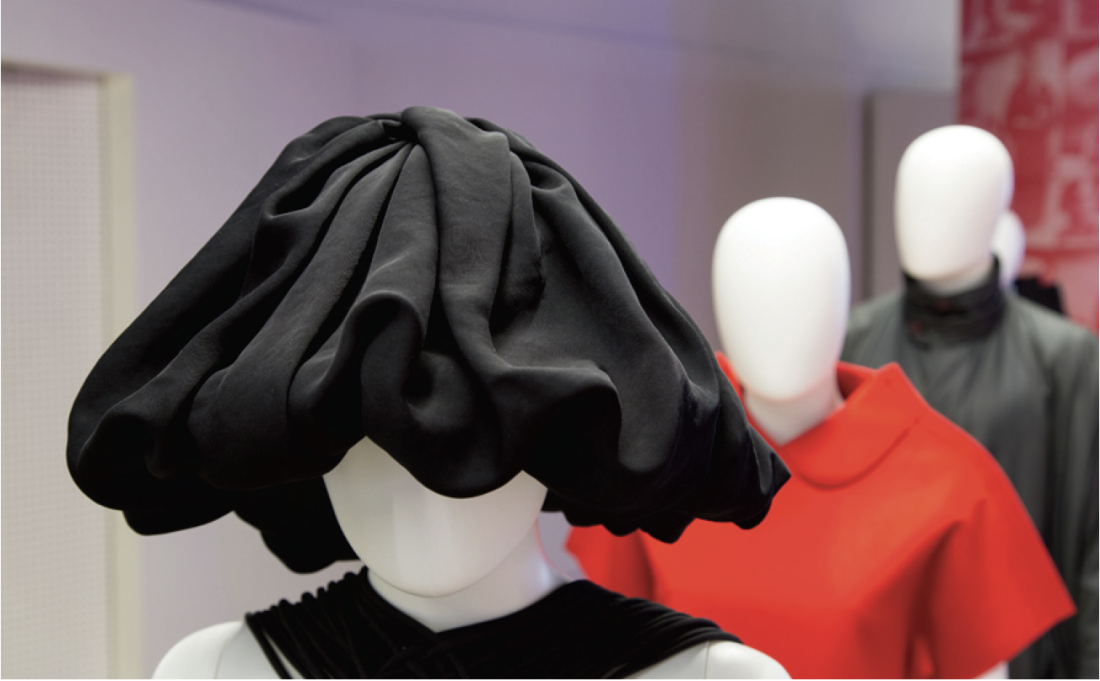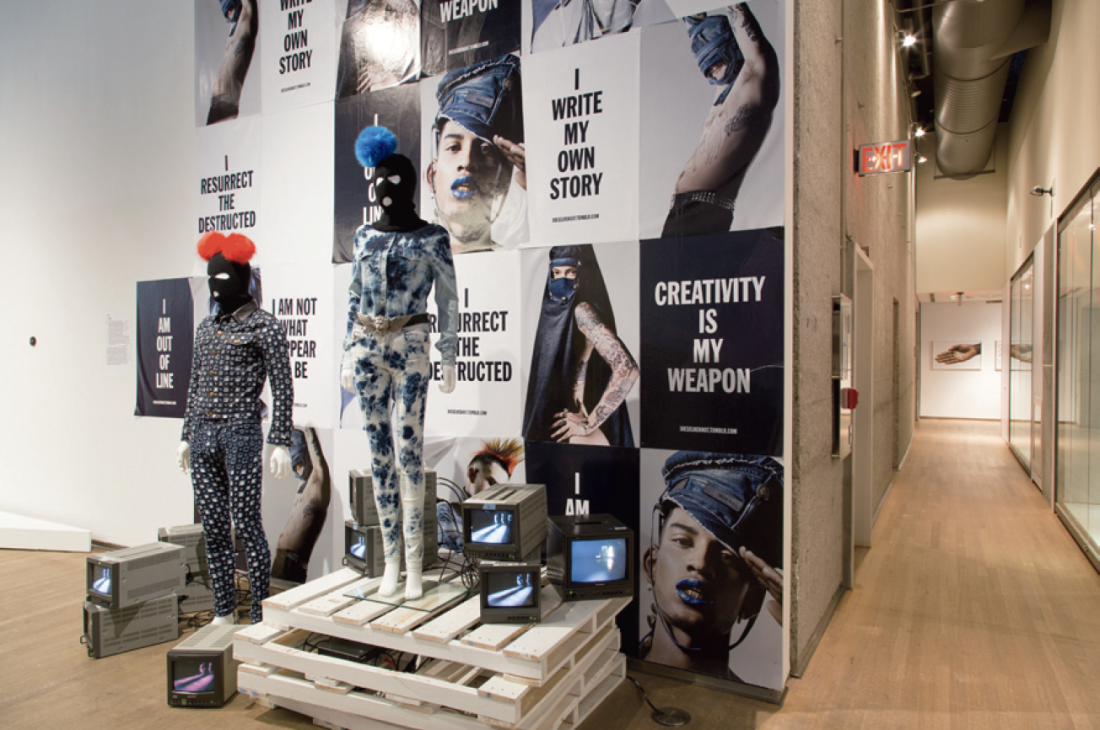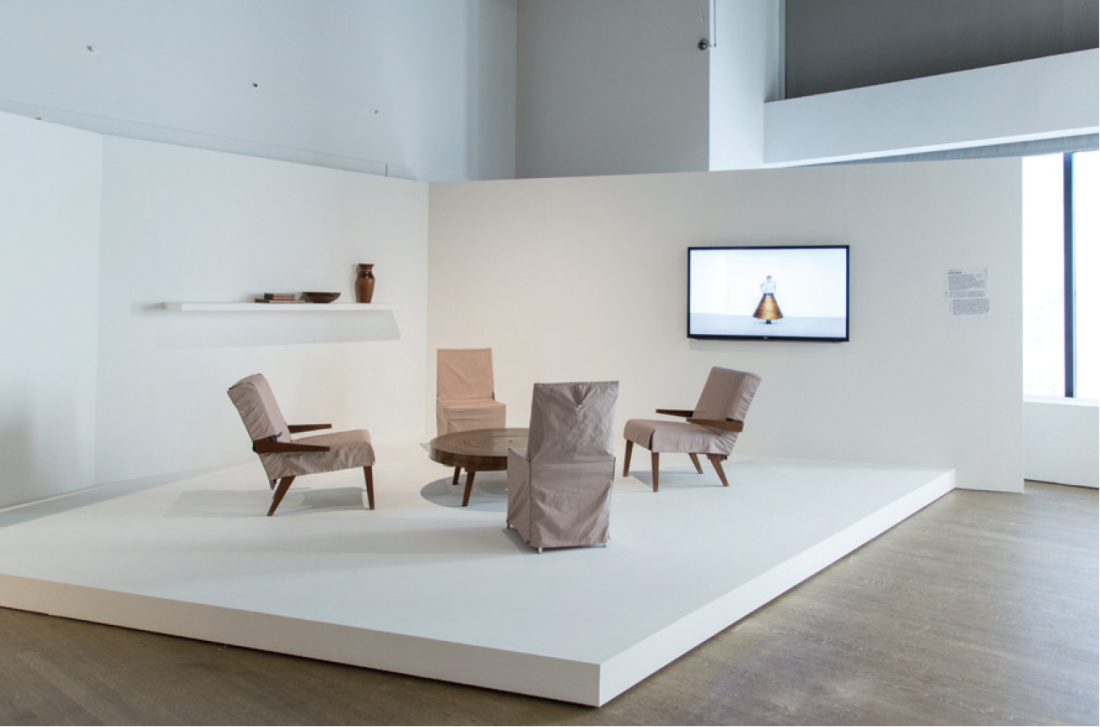The Politics of Fashion | Fashion of Politics
If nudity is disconcealment in its most classical form, then to cover a body with clothing is the prototypical obscuration. The foundation for this binary is laid in the Abrahamic religions when, at the moment of humanity’s fall, Adam and Eve hide their naked bodies with fig leaves as their new knowledge of Good and Evil removes from them the clothing of grace. Upon their expulsion from Eden they leave, concealing their nakedness in garments made from animal skins, and revealing, in their adornment, humanity’s flawed and impulsive nature. As a story that is known to so many people, the concept of clothing, especially in the West, is inextricably tied to our understanding of human frailty and weakness, exhibiting itself in plain view as a site for ongoing political intervention.

Comme des Garcons, Draped Hat, 1990. All images courtesy Faulhaber Communications, Toronto.
At the Design Exchange’s “Politics of Fashion,” this political potential is signalled through examples pulled from the second half of the 20th century, highlighting those designers, activists, and subcultures that identify a revelatory promise in what we choose to wear. Housed within the second floor of the old Toronto Stock Exchange, the exhibition is organized in a manner that acknowledges the immanent tension between what is disclosed and what is veiled when we slip into or out of our daily dress. Arranged in a series of crudely constructed alcove-like dioramas—aesthetically influenced by the riotous interventions of the radical groups FEMEN and PETA—each discrete vignette exhibits a particular strain of political engagement. Standouts include video and ephemera from PETA’s 1993 sit-in at the Vogue offices, the working-class roots of pre-white nationalist skinheads, a Klaus Nomi faux tuxedo and finally, the installation’s L-shaped extension that presents the carefully programmed outfits worn by recent and contemporary political leaders. Instances such as these weave moments of so-called “low culture” throughout the otherwise luxury-laden presentation.
The majority of the exhibition though, is devoted to luxury designs from the post WWII period, the time when a newly affluent population began bringing fashion magazines into their homes, aspiring to replicate the images seen in their pages. It is this social and economic context the designers have selected for “The Politics of Fashion,” pitting the industry’s expectations against themselves. This push against tradition is best manifest in examples from Maison Martin Margiela’s ‘Artisanal’ collection, which includes a dystopic, dysfunctional poncho built from an array of found leather biker jackets that have been ripped apart and re-sewn to construct a new, weighty structure.

Diesel A/W, 2014, Tie-dye button-up shirt, tie-dye jeans, belt, cotton and leather, from the collection of Diesel Venice. Photograph: Arash Moallemi.
There are multiple examples of more explicitly political endeavours as well. T-shirts emblazoned with anarchist cries from Vivienne Westwood and Malcolm McLaren’s boutique, SEX, on King’s Road in London, and Katharine Hamnett’s block letter sloganeering, which covers the interior of the elevator ascending to the exhibition’s entrance. The most memorable moment though, is found in the guise of a muted tableau of drab chairs, positioned around a circular wooden coffee table. The scene re-presents Hussein Chalayan’s 2000 collection Afterwords, in which models happen upon this staged scene, un-zipping each chair’s upholstery and proceeding to clothe themselves in the resultant shift dresses. The chairs are then folded into luggage and marched off stage. A final model appears and steps into the centre where the table remains, and which she pulls into a tiered, wooden, floor-length skirt, in which she too exits. Conceived in relation to Chalayan’s own family’s forced migration within Cyprus in the 1970s, and coming on the heels of the mass displacement of Albanians and Serbians following the conflict in Kosovo, Afterwords remains a beacon for the political potential that might be available within the medium. It offers something of an isolated moment within the industry though, especially as the racks of the nearby high-end department stores are filled with designer wares hijacking the aesthetic of marketable subcultures and radical groups, homogenizing any political message into a trend-worthy ‘look.’ There are culprits of this appropriation to be found in “The Politics of Fashion” as well: Jeremy Scott’s ridiculous “Arab Spring” collection and Diesel’s use of the Pussy Riot ski mask for their runway show and ad campaign, both of which seem to contradict the show’s thesis that fashion influences politics. Instead, the inverse is made clearly evident.
Chalayan’s collection, however, continues to speak to humanity’s flawed condition through its deployment of clothing as allegory, revealing the latent political potential in our closest bodily architecture. Carried upon our backs, this potential remains primed for further intervention as we collectively move through and across new political territories in search of some unknown Edenic resting place where our frailty may no longer require such concealment. ❚

Hussein Chalayan, Afterwords, 2000, fabrics, wood, video, from the collection of MUDAM Luxemburg. Photograph: Arash Moallemi.
“Politics of Fashion | Fashion of Politics,” curated by Jeanne Beker with Sara Nickelson, was exhibited at the Design Exchange, Toronto, from September 18, 2014 to January 25, 2015.
Aryen Hoekstra is an artist based in Toronto where he currently serves as the director of G Gallery.

